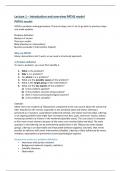Samenvatting
Behavioral Change - Summary of Lectures 1 - 4 + Literature
- Instelling
- Tilburg University (UVT)
Summary of lectures 1, 2, 3 and 4, including summaries of the papers. Lectures 5, 6 and 7 are guest lectures without relevant theory and are therefore not included in this summary.
[Meer zien]




